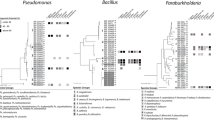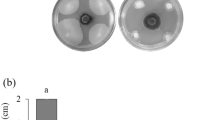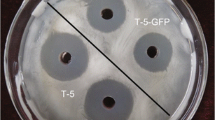Abstract
Bacillus megaterium strainB153-2-2 is a potential bacterial biocontrol agentagainst Rhizoctonia solani isolate 2B12(ISG-2B). To study the role of antagonism (Ant),chemotaxis (Che), motility (Mot), and sporulation(Spo) of the biocontrol agent during seed and rootcolonization and the correlation between rootcolonization and the suppression of soybean (Glycine max) root rot caused by R. solani,strain B153-2-2(Che+Mot+Ant++Spo++) and the sevenderived mutants with altered antagonism, chemotaxis,motility, and/or sporulation were used. The bacterialcells were introduced into soil separately either asa soybean seed coating or soil application. Two soilmixtures defined as coarse and fine soil were used. The bacterial cell chemotactic response to soybeanroot and seed exudates and antagonism to R.solani were significantly (p = 0.05) correlatedwith root and seed colonization in some but not alltreatments. The sporulation-defective mutants had lowcell populations immediately after application and,therefore, reduced root colonization. The differencesin root colonization diminished among the mutants andstrain B153-2-2 when R. solani was present inthe soil or, as seedlings grew older. Soybean seedlingroots grown in coarse soil had significantly greatercolonization by B153-2-2 or its mutants and a lowerdisease index than that in fine soil. There was asignificant positive correlation (r 2 = 0.78)between root colonization by strain B153-2-2 or itsmutants and suppression of Rhizoctonia root rot.
Similar content being viewed by others
References
Ames, P. and K. Bergman, 1981. Competitive advantage provided by bacterial motility in the formation of nodules by Rhizobium meliloti. J.Bacteriol. 148: 728–729.
Bashan Y., 1986. Migration of the rhizosphere bacteria Azospirillium brasilense and Pseudomonas fluorescens toward wheat roots in soil. J.Gen.Microbiol. 132: 3401–3414.
Becker, J.O. and F.J. Schwinn, 1993. Control of soil-borne pathogens with living bacteria and fungi: status and outlook. Pesticide Science 37: 355–363.
Bull, C.T., 1987. Wheat root colonization by disease-suppressive or nonsuppressive bacteria and the effect of population size on severity of take-all caused by Gaeumannomyces graminis var. tritici. MS thesis. Washington State Univesrsity, Pullman. 75 pp.
Chet, I., A. Ordentlich, R. Shapira and A. Oppenheim, 1991. Mechanisms of biocontrol of soil-borne plant pathogens by Rhizobacteria. In: D. L. Keister and P. B. Cregan (eds), The Rhizosphere and Plant Growth. Kluwer Academic Publishers, Dordrecht. pp. 229–236.
Curl, E.A. and B. Truelove, 1986. The Rhizosphere. In: D.F.R. Bommer, B.R. Sabey, G.W. Thomas, L.Y. Vaadia, L.D. Van Vleck (eds), Advanced Series in Agricultural Science 15. Springer Verlag, Berlin/New York. pp. 55–92.
Currier, A.W. and G.A. Strobel, 1981. Characterization and biological activity of trefoil chemotactin. Plant Sci.Letter 21: 159–165.
DeWeger, L.A., C.I.M. van der Vlugt, A.H.M. Wijfies, P. A.H.M. Bakker, B. Schippers and B. Lugtenberg, 1987. Flagella of a plant-growth-stimulating Pseudomonas fluorescens strain are required for colonization of potato roots. J.Bacteriol. 169: 2769–2773.
Duffy B.K. and D.M. Weller, 1996. Biological control of take-all of wheat in the Pacific Northwest of the USA using hypovirulent Gaeumannomyces graminis var. tritici and fluorescent pseudomonads. J.Phytopathol. (Berlin) 144: 11–12.
Ferriera, J.H.S., F.N. Matthee and C. Thomas, 1991. Biological control of Eutypa lata on grapevine by antagonistic strain of Bacillus subtilis. Phytopathology 81: 283–287.
Fravel, D.R., 1988. Role of antibiosis in the biocontrol of plant diseases. Annu.Rev.Phytopathol. 26: 75–91.
Gaworzewska, E.T. and M.J. Carlile, 1982. Positive chemotaxis of Rhizobium leguminosarum and other bacteria towards root exudates from legumes and other plants. J.Gen.Microbiol. 128: 1179–1188.
Gulash, M., P. Ames, R.C. Larosiliere and K. Bergman, 1984. Rhizobia are attracted to localized sites on legume roots. Appl.Environ.Microbiol. 48: 149–152.
Hallmann J., A. Quadt Hallmann, W.F. Mahaffee and J.W. Kloepper, 1997. Bacterial endophytes In agricultural crops. Can.J.Microbiol. 43: 895–914.
Handelsman, J. and J.L. Parke, 1989. Mechanisms in biocontrol of soilborne plant pathogens. In: T. Kosuge and E.W. Nester (ed.), Plant-Microbe Interaction: Molecular and Genetics Perspectives. McGraw-Hill, New York. pp. 27–61.
Heinrich, D. and D. Hess, 1985. Chemotactic attraction of Azospirillium lipoferum by wheat roots and characterization of some attractants. Can.J.Microbiol. 31: 26–31.
Howie, W.J., R.J. Cook and D.M. Weller, 1987. Effects of soil matrix potential and cell motility on wheat root colonization by fluorescent Pseudomonads suppressive to take-all. Phytopathology 77: 286–292.
Hunter, W.J. and C.J. Fahring, 1980. Movement by Rhizobium and nodulation of legumes. Soil Biol.Biochem. 12: 537–542.
Kerr, A., 1980. Biological control of crown gall through production of agrocin 84. Plant Dis. 64: 25–30.
Liu, Z., 1990. Rhizoctonia disease of soybeans and its potential biological control by Bacillus megaterium. Ph. D. thesis. University of Illinois at Urbana-Champaign. 247 pp.
Liu, Z. and J.B. Sinclair, 1991. Isolates of Rhizoctonia solani anastomosis group 2–2 pathogenic to soybean. Plant Dis. 75: 682–687.
Liu, Z. and J.B. Sinclair, 1992. Population dynamics of Bacillus megaterium strain B153–2–2 in the rhizosphere of soybean. Phytopathology 82: 1297–1301.
Liu, Z. and J.B. Sinclair, 1993. Colonization of soybean roots by Bacillus megaterium B153–2–2. Soil Biol.Biochem. 25: 849–855.
Maplestone, P.A. and R. Campbell, 1988. Colonization of roots of wheat seedlings by Bacilli proposed as biocontrol agents against take-all. Soil Biol.Biochem. 21: 543–550.
Mazzola, M., R.J. Cook, L.S. Thomashow, D.M. Weller and L.S. Pierson III, 1992. Appl.Environ.Microbiol. 58: 2616–2624.
Mukhopadhyay, A.N. and P.K. Mukherjee, 1996. Fungi as fungicides. Inter.J.Trop.Plant Diseases 14: 1–17.
Napoli, C. and P. Albersheim, 1980. Infection and nodulation of clover by non-motile Rhizobium trifolii. J.Bacteriol. 141: 979–980.
Parke, J.L., 1991. Root colonization by indigenous and introduced microorganisms. In: D.L. Keister and P.B. Cregan (eds), The Rhizosphere and Plant Growth. Kluwer Academic Publishers, Dordrecht/Boston/London. pp. 33–42.
Punja, Z.K., 1997. Comparative efficacy of bacteria, fungi, and yeasts as biological control Agents for diseases of vegetative crops. Can.J.Plant Pathol. 19: 315–323.
Scher, F.M., J.W. Kloepper, C.A. Singleton, I. Zaleska and M. Laliberte, 1988. Colonization of soybean roots by Pseudomonas and Serratia species: Relationship to bacterial motility, chemotaxis, and generation time. Phytopathology 78: 1055–1059.
Soby, S. and K. Bergman, 1983. Motility and chemotaxis of Rhizobium meliloti in soil. Appl.Environ.Microbiol. 46: 995–998.
Suslow, T.V., 1982. Role of root-colonizing bacteria in plant growth. In: M.S. Mount and G.H. Lacy (eds), Phytopathogenic Prokaryotes. Academic Press, New York. pp. 187–223.
Thomson, J.A., 1987. The use of agrocin-producing bacteria in the biological control of crown gall. In: I. Chet (ed.), Innovative Approaches to Plant Disease Control. John Wiley & Sons, New York. pp. 213–228.
van Lierop, W., 1990. Soil pH and lime requirement determination. In: R.L. Westerman (ed.), Soil Testing and Plant Analysis, 3rd edition. SSSA Inc., Madison. pp. 75–126.
Weller, D.M., 1988. Biological control of soilborne plant pathogens in the rhizosphere with bacteria. Annu.Rev.Phytopathol. 26: 379–407.
Zheng, X.Y. and J.B. Sinclair, 1996a. Chemotactic response of Bacillus megaterium strain B153–2–2 to soybean root and seed exudates. Physiological and Molecular Plant Pathology 84: 21–35.
Zheng, X.Y. and J.B. Sinclair, 1996b. Screening and isolation of mutants of Bacillus megaterium B153–2–2 for motility, chemotaxis, antagonism, and sporulation. Physiological and Molecular Plant Pathology 84: 233–244.
Author information
Authors and Affiliations
Corresponding author
Rights and permissions
About this article
Cite this article
Zheng, X.Y., Sinclair, J.B. The effects of traits of Bacillus megaterium onseed and root colonization and their correlation withthe suppression of Rhizoctonia root rot of soybean. BioControl 45, 223–243 (2000). https://doi.org/10.1023/A:1009998304177
Issue Date:
DOI: https://doi.org/10.1023/A:1009998304177




